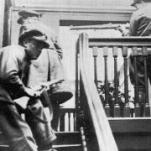The Civil War In Dublin: Images from Irish Life (July 1922)
Published on 26th January 2012
 On 28 June 1922 the forces of the Provisional Government of the Irish Free State, led by Michael Collins, attacked the Anti-Treaty garrison at the Four Courts. This action is generally believed to mark the beginning of the Irish Civil War. Fighting spread to the centre of the city with Anti-Treaty troops occupying part of O’Connell Street (including the Gresham, Crown, Granville and Hammam Hotels) as well as outposts on Gardiner Street, Parnell Street, and Aungier Street. The Anti-Treaty forces were defeated after a week of heavy bombardment and street fighting. Over three hundred combatants were killed or wounded with Republican leader Cathal Brugha among the fatalities. Over two hundred civilians were killed during ‘the Battle of Dublin’ that lasted from 28 June to the 5 July 1922.
On 28 June 1922 the forces of the Provisional Government of the Irish Free State, led by Michael Collins, attacked the Anti-Treaty garrison at the Four Courts. This action is generally believed to mark the beginning of the Irish Civil War. Fighting spread to the centre of the city with Anti-Treaty troops occupying part of O’Connell Street (including the Gresham, Crown, Granville and Hammam Hotels) as well as outposts on Gardiner Street, Parnell Street, and Aungier Street. The Anti-Treaty forces were defeated after a week of heavy bombardment and street fighting. Over three hundred combatants were killed or wounded with Republican leader Cathal Brugha among the fatalities. Over two hundred civilians were killed during ‘the Battle of Dublin’ that lasted from 28 June to the 5 July 1922.
The images in this gallery are taken from a special supplement to the Irish Life newspaper that was published on 14 July 1922 entitled 'Ireland's Tragic Week'. Each photograph was accompanied by a short text. As you can discern, the editors of the Irish Life did not take an unbiased view of the hostilities. We have reprinted the accompanying text unedited and as it originally appeared in the pages of Irish Life.
We hope that these images may be of general interest and, in particular, to anyone doing research or a school project on the Civil War in Dublin.
Further Resources
Dublin City Libraries has a wide range of sources on the social, political, and cultural history of Dublin, some of which are available online and some through the Dublin City Libraries network.
The Reading Room, Dublin City Library and Archive, Pearse Street holds a wealth of material on the history of Dublin, including books, pamphlets, journals, street directories, and almanacs.
The following online resources can be accessed free of charge at your local library. Ask library staff for information and assistance.
- DRI - Digital Repository of Ireland is a national digital repository for Ireland’s humanities, social sciences, and cultural heritage data. Here you will find select digital collections of Dublin City Library and Archive. Our digital repository features photographs, postcards, letters, maps and more. Traffic jams during the 1974 CIE Bus Strikes, and jubilant Heffo’s army supporters are among 43,000 historic photographs and documents that are freely available online. Highlights of the collection include the Fáilte Ireland Photographic Collection, the Jacobs Biscuit Factory Photographic Archive, and the Royal Dublin Fusiliers Association Archive.
- Irish Times Digital Archive: This online archive service gives access to contemporary editions of the Irish Times from the mid-nineteenth century until the present.
- Irish Newspaper Archive: This online archive service gives access to contemporary editions of the Irish Independent and a range of other newspapers.
- The Ireland-JSTOR Collection: This online archive of academic articles can also be accessed free of charge at your local library.
For further reading, consult the Library Catalogue.
